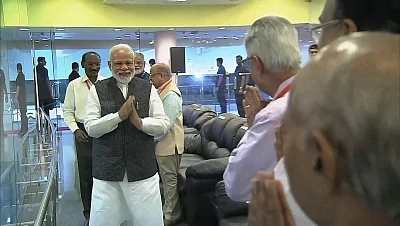Bengaluru, Sep 7 (IANS) Prime Minister Narendra Modi arrived at the ISRO space centre here early Saturday to watch India land near the moon's south pole, with its lander Vikram carrying the lunar rover Pragyan, an official said.
"Modi drove from a nearby star hotel where he is staying overnight to the space agency's telemetry, tracking and command network (Istrac) to witness the historic event, with about 800 scientists and engineers of the Indian Space Research Organisation (ISRO) working over the last 46 days to accomplish the country's ambitious Chandrayaan-2 mission," the official told IANS.
Modi was welcomed at the centre by ISRO chief K. Sivan and other top officials.
This is the second time Modi is witnessing an inter-planetary mission in 5 years at Istrac after watching India enter the Martian orbit in its first attempt on September 24, 2014 following a nine-month voyage by the Mars Orbiter Mission (MOM) or Mangalyaan to the red planet.
Sivan and senior space officials briefed Modi on the second lunar mission's journey over the last 46 days since it was launched on July 22 onboard a heavy rocket from its spaceport at Sriharikota.
"Modi has been keeping a track of all our missions, programmes and activities. He will witness live the descent of Vikram and its soft-landing when shown through telemetry signals on the giant computer screens or panels," a space official said.
After the landing, the Prime Minister will greet the scientists and engineers and address them on the occasion. He will also interact with about 70 young students ISRO has ferried them from across the country after selecting them in an online space quiz.
"The Prime Minister, however, will not be staying to watch the six-wheel Pragyan roll out out of Vikram on a ramp for a stroll to study the lunar surface and conduct a few specific experiments," the official added.
The 1,471-kg 'Vikram' has been named after Dr Vikram A Sarabhai, father of the Indian space programme.
The 27-kg robotic vehicle Pragyan, which in Sanskrit means wisdom, will ride at a snail's space for about 500 metres from the landing spot drawing energy from its solar panels.
The lander and rover have been designed to last for one lunar day, which is equivalent to 14 earth days.
Vikram has three instruments to conduct surface and sub-surface science experiments, while Pragyan has two instruments to enhance the understanding of the lunar surface.
During the course of the lunar day, Pragyan will explore the lunar terrain in a 500-metre range around Vikram.
Earlier on Friday, Modi urged all the people across the country to watch the special moments of Vikram descending on to the lunar south pole.
"Do share your photos on social media. I will re-tweet some of them too," he tweeted.
--IANS
fb/vd
(At The Quint, we question everything. Play an active role in shaping our journalism by becoming a member today.)
